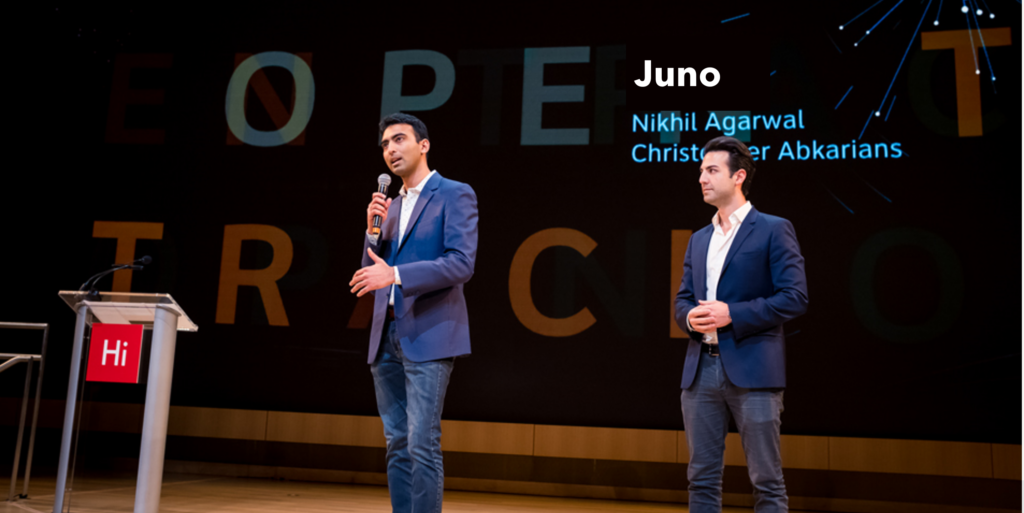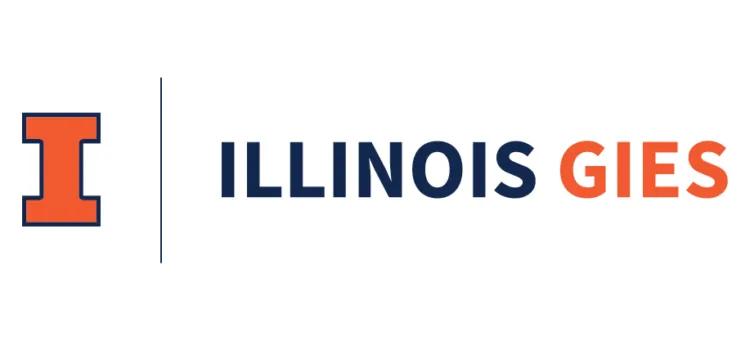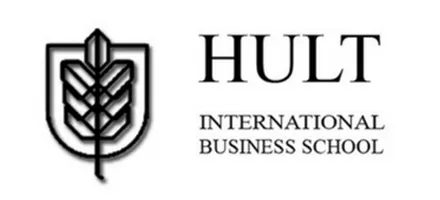
Juno Co-founders Chris Abkarians and Nikhil Agarwal talk about their company shortly after its founding. Courtesy photo
A familiar player on the student loan scene is promoting a new program that will raise more than a few eyebrows.
Juno uses collective bargaining to negotiate better terms for private student loans. Four years after launching with about 700 MBA students from elite business schools, Juno reached an impressive milestone last week: More than 100,000 students and parents are now leveraging their combined buying power through Juno to secure the lowest interest rates available.
Now, its business model stronger than ever, the company is introducing a low-rate guarantee program negotiated for its undergrad borrowers: Juno members who sign with their primary lending partner will receive 2% cash back ($400 on a $20,000 loan). If you find a lower rate, Juno will match it AND give you 3% cash back ($600 on a $20,000 loan).
LEVERAGING THE POWER OF 100,000+ BORROWERS
Juno is not a direct lender for student loans. Rather, it invites banks, credit unions, and fintech lenders to bid for the chance to service Juno’s borrower groups, using collective bargaining to get borrowers the lowest rates and fees.
 “We made a very important decision in year one which was to promise to never become a direct lender,” Chris Abkarians, Juno’s co-founder and CEO, tells P&Q. “Because the moment you do that, you lose the flexibility to be able to introduce people to another lender who might be able to offer lower rates. That’s our No. 1 objective: To make sure we’re always in a position to guide people, honestly, to what we believe is the lowest cost source of financing for them.”
“We made a very important decision in year one which was to promise to never become a direct lender,” Chris Abkarians, Juno’s co-founder and CEO, tells P&Q. “Because the moment you do that, you lose the flexibility to be able to introduce people to another lender who might be able to offer lower rates. That’s our No. 1 objective: To make sure we’re always in a position to guide people, honestly, to what we believe is the lowest cost source of financing for them.”
Thought it began as a collective bargaining group for MBA students, Juno has expanded its collective bargaining model to graduate students in any program — including law and medical schools – at every nonprofit college in the United States, as well as about 150 schools outside of the U.S. It also offers deals for undergraduate, DACA and international students along with loan refinancing and parent loans. To date, it has secured more than $460 million in loans for its users with interest rates that are, on average, 1.6% lower than they would have otherwise gotten. (Read more of Poets&Quants‘ coverage of Juno here.)
JUNO’S ORIGIN STORY
Juno, then known as LeverEdge, was founded in the summer of 2018 by Abkarians and Nikhil Agarwal as the two were preparing to start the MBA program at Harvard Business school.
The idea grew out of a WhatsApp conversation between a group of incoming HBS students who were comparing their credit histories and other metrics with the loan rates they were getting. They wondered: What would happen if they pooled their buying power to get the same bulk discount for student loans that other student groups got to buy, say, laptops?
With a core group of 75 HBS students, they reached out to several lenders looking for a bulk rate–and they were turned down by nearly every one. However, Anthony Noto, now CEO of SoFi and former COO of Twitter, returned their cold Linked-In Message: Interesting idea, he told them. Grow the number to 500 and we’ll talk.
Abkarians and Agarwal reached out to MBAs at nine other business schools leveraging Facebook and other social channels. The number ballooned to nearly 700, and they went back to the lenders. They landed on one that saved each student an average of $10,000 in interest and fees compared to federal student loan rates at the time.

Chris Abkarians, left, and Nikhil Agarwal founded LeverEdge in the summer of 2018. The company has since rebranded as Juno. Courtesy photo
HOW IT WORKS
Juno leverages the number of its users to negotiate volume-based discounts with lending agencies. It is free for potential borrowers to join, and the more borrowers it signs up, the better their leveraging power.
“We don’t accept anybody’s payment information, but we do get paid when someone actually closes on a loan using the products that we’ve negotiated,” Abkarians says. “But (borrowers) only use it if it’s actually the lowest cost product that they can get.”
Juno collects certain member information in order to group borrowers into bargaining segments. For example, they ask borrowers for estimated credit scores, certain financial information, amount of loans needed, education goals, etc., to build a group portfolio with which to approach lenders.
Each spring, it kicks off a new round of competitive bids, reaching out to dozens of lenders and informing them of the borrower groups’ size and portfolio. It asks them to submit terms for the different groups, Juno evaluates each bid, negotiating better terms when it can, to select the lender that offers the best terms.
“In our RFP, we lay out very clearly the standardized terms that are best in the market and that they would have to meet,” Abkarians says. “We don’t let anybody respond if they are going to charge fees–whether that’s an original fee, prepayment penalties, or application fees.”
This approach is novel in the market so far, and it allows Juno to expand its outreach beyond just the traditional student loan lenders. Too many people, Abkarians says, learn about important financial products by doing a Google search–whether it’s for a low-rate mortgage or a student loan. That means the company that comes up first in the search results isn’t necessarily that company with the best product. Rather, it’s the company with the highest marketing and advertising budget and those marketing costs are almost always passed on to the customer.
Juno works to bypass that. It can reach out to companies that never competed in the student loan market before and offer them a group of borrowers they don’t have to pay a marketer to reach, Abkarians.
WHAT COMES NEXT
Juno’s new cash-back guarantee was an objective the company’s founders have been working on since their first month in business, Abkarians tells P&Q. It’s a signal to students that Juno is confident in their service while building user trust in what they are doing.
“It just took us four years to get here because we had to get to a scale that would convince our lending partners to do it,” Abkarians says. “When you’re running a business, what you care about, in part, is: ‘Can I hold my head up high and know that the product I’m putting out there is one that I would use myself without hesitation?’ The structure of it now is one where the answer to that is, ‘Yes,’ and I feel really good about it.”
As for what comes next, Abkarians is confident that the Juno model would work for financial products outside of student lending as well.
“I think it shows the power of community from both a consumer perspective and in a business setting. I think the thing I’m most proud of in being a part of Juno is working to build a strong community that actually materially made an impact in one of the most obscure consumer financial markets there is,” says Pedro Russell, head of Juno’s strategy and business development.
Russell is starting his own MBA at MIT Sloan this fall. While he actually secured a full-ride scholarship, he will use Juno’s collective bargaining power if he needs a loan for extra expenses. Juno also helps students lower their loan amounts by offering scholarship databases and even two scholarships of its own.
Russell’s MBA journey is a little unorthodox, he tells P&Q. He got his first job at 14, started at community college, and bartended nights and weekends to help pay for his undergrad. He had to take out a private loan for his last semester of college, and it had an interest rate of 15%.
“I majored in finance, and I know that a 1% difference in interest rate can mean a $15,000 to $20,000 impact down the line,” he says. “We can take millions and millions of dollars out of student lenders’ pockets and put them back into the hands of consumers. I think we can change the world with this company.”
Students and parents can sign up for Juno for free and with no obligations at joinjuno.com.
LEARN MORE ABOUT JUNO AND FINANCING YOUR SCHOOL IN OUR FINANCING HUB
AND DON’T MISS OPTIMAL STRATEGIES FOR MBA STUDENT LOANS and HOW TWO HBS STUDENTS CHANGED THE STUDENT LOAN MARKET
© Copyright 2025 Poets & Quants. All rights reserved. This article may not be republished, rewritten or otherwise distributed without written permission. To reprint or license this article or any content from Poets & Quants, please submit your request HERE.










